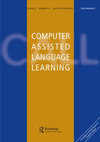Mobile-assisted ESL/EFL vocabulary learning: a systematic review and meta-analysis
来源期刊:Computer Assisted Language LearningDOI:10.1080/09588221.2018.1541359
Student satisfaction, learning outcomes, and cognitive loads with a mobile learning platform
来源期刊:Computer Assisted Language LearningDOI:10.1080/09588221.2018.1517093
Using gamification to support learning English as a second language: a systematic review
来源期刊:Computer Assisted Language LearningDOI:10.1080/09588221.2019.1648298
E-learning: development of a model to assess the acceptance and readiness of technology among language learners
来源期刊:Computer Assisted Language LearningDOI:10.1080/09588221.2019.1640255
Teachers’ perception about the contribution of collaborative creation of digital storytelling to the communicative and digital competence in primary education schoolchildren
来源期刊:Computer Assisted Language LearningDOI:10.1080/09588221.2018.1517094
An English vocabulary learning app with self-regulated learning mechanism to improve learning performance and motivation
来源期刊:Computer Assisted Language LearningDOI:10.1080/09588221.2018.1485708
Students’ reactions to using smartphones and social media for vocabulary feedback
来源期刊:Computer Assisted Language LearningDOI:10.1080/09588221.2018.1541360
Examining EFL learners’ individual antecedents on the adoption of automated writing evaluation in China
来源期刊:Computer Assisted Language LearningDOI:10.1080/09588221.2018.1540433
A systematic review of the uses and spread of corpora and data-driven learning in CALL research during 2011–2015
来源期刊:Computer Assisted Language LearningDOI:10.1080/09588221.2019.1667832
Raising native cultural awareness through WeChat: a case study with Chinese EFL students
来源期刊:Computer Assisted Language LearningDOI:10.1080/09588221.2019.1629962
Blended learning for Chinese university EFL learners: learning environment and learner perceptions
来源期刊:Computer Assisted Language LearningDOI:10.1080/09588221.2019.1607881
Effects of using mobile-based virtual reality on Chinese L2 students’ oral proficiency
来源期刊:Computer Assisted Language LearningDOI:10.1080/09588221.2019.1604551
Promotion of learner autonomy within the framework of a flipped EFL instructional model: perception and perspectives
来源期刊:Computer Assisted Language LearningDOI:10.1080/09588221.2019.1650779
Fostering accuracy in L2 writing: impact of different types of corrective feedback in an experimental blended learning EFL course
来源期刊:Computer Assisted Language LearningDOI:10.1080/09588221.2019.1635164
Exploring the frontiers of eye tracking research in language studies: a novel co-citation scientometric review
来源期刊:Computer Assisted Language LearningDOI:10.1080/09588221.2019.1647251
Chinese postgraduate EFL learners’ self-directed use of mobile English learning resources
来源期刊:Computer Assisted Language LearningDOI:10.1080/09588221.2019.1662455
Diagnosing L2 learners’ development through online computerized dynamic assessment
来源期刊:Computer Assisted Language LearningDOI:10.1080/09588221.2019.1645181
Linking text readability and learner proficiency using linguistic complexity feature vector distance
来源期刊:Computer Assisted Language LearningDOI:10.1080/09588221.2018.1527358
The efficiency of prompts when supporting learner use of cognitive and metacognitive strategies
来源期刊:Computer Assisted Language LearningDOI:10.1080/09588221.2018.1459729
Vlogs in L2 listening: EFL learners’ and teachers’ perceptions
来源期刊:Computer Assisted Language LearningDOI:10.1080/09588221.2019.1658608
The applications and effects of learning English through augmented reality: a case study of Pokémon Go
来源期刊:Computer Assisted Language LearningDOI:10.1080/09588221.2019.1642211
Delving into learner autonomy in an EFL MOOC in China: a case study
来源期刊:Computer Assisted Language LearningDOI:10.1080/09588221.2019.1681464
Pre-service language teachers’ online written corrective feedback preferences and timing of feedback in computer-supported L2 grammar instruction
来源期刊:Computer Assisted Language LearningDOI:10.1080/09588221.2019.1668811
A comparative study of lexical word search in an audioconferencing and a videoconferencing condition
来源期刊:Computer Assisted Language LearningDOI:10.1080/09588221.2018.1527359
The emergence and influence of group leaders in web-based collaborative writing: self-reported accounts of EFL learners
来源期刊:Computer Assisted Language LearningDOI:10.1080/09588221.2019.1650781
Effects of regulation on interaction pattern in web-based collaborative writing activity
来源期刊:Computer Assisted Language LearningDOI:10.1080/09588221.2019.1667831
The effects of symmetric and asymmetric social networks on second language communication
来源期刊:Computer Assisted Language LearningDOI:10.1080/09588221.2018.1527364
Moving literature circles into wiki-based environment: the role of online self-regulation in EFL learners’ attitude toward collaborative learning
来源期刊:Computer Assisted Language LearningDOI:10.1080/09588221.2018.1527363
Practicing multiliteracies to enhance EFL learners’ meaning making process and language development: a multimodal Problem-based approach
来源期刊:Computer Assisted Language LearningDOI:10.1080/09588221.2019.1614959
Exploring EFL learners` developmental errors in academic writing through face-to-Face and Computer-Mediated dynamic assessment
来源期刊:Computer Assisted Language LearningDOI:10.1080/09588221.2019.1698616
Evaluating English language learners’ conversations: Man vs. Machine
来源期刊:Computer Assisted Language LearningDOI:10.1080/09588221.2018.1517126
Toward a neuroscience-informed evaluation of language technology
来源期刊:Computer Assisted Language LearningDOI:10.1080/09588221.2018.1516675
Wiki-mediated collaboration and its association with L2 writing development: an exploratory study
来源期刊:Computer Assisted Language LearningDOI:10.1080/09588221.2018.1542407
L2 vocabulary learning from educational media: extending dual-coding theory to dual-language learners
来源期刊:Computer Assisted Language LearningDOI:10.1080/09588221.2019.1666150
Learning French through music: the development of the Bande à Part app
来源期刊:Computer Assisted Language LearningDOI:10.1080/09588221.2018.1472616
Improving children’s textual cohesion and writing attitude in a game-based writing environment
来源期刊:Computer Assisted Language LearningDOI:10.1080/09588221.2019.1671459
Exploring the differences between low-stakes proctored and unproctored language testing using an Internet-based application
来源期刊:Computer Assisted Language LearningDOI:10.1080/09588221.2018.1527360
Teacher training and teachers’ attitudes towards educational technology in the deployment of online English language courses in Jordan
来源期刊:Computer Assisted Language LearningDOI:10.1080/09588221.2018.1531033
The effect of tutor-specific and other motivational factors on student retention on Icelandic Online
来源期刊:Computer Assisted Language LearningDOI:10.1080/09588221.2019.1633357
Collaborative kinesthetic EFL learning with collaborative total physical response
来源期刊:Computer Assisted Language LearningDOI:10.1080/09588221.2018.1540432
The comparative effects of metalinguistic clue and metalinguistic explanation in computer-mediated form-focused practice: Does prior knowledge matter?
来源期刊:Computer Assisted Language LearningDOI:10.1080/09588221.2018.1488736
CALL Beliefs in Context: a Study of US High School Foreign Language Learners
来源期刊:Computer Assisted Language LearningDOI:10.1080/09588221.2019.1643739
The effects of intrinsic cognitive load and gameplay interest on flow experience reflecting performance progress in a Chinese remote association game
来源期刊:Computer Assisted Language LearningDOI:10.1080/09588221.2019.1614068
Telepresence-place-based foreign language learning and its design principles
来源期刊:Computer Assisted Language LearningDOI:10.1080/09588221.2019.1690527
The effect of four of Richard Mayer’s design principles on vocabulary retention in an Afrikaans computer programme
来源期刊:Computer Assisted Language LearningDOI:10.1080/09588221.2018.1488737
Complementing in-class language learning with voluntary out-of-class MALL. Does training in self-regulation and scaffolding make a difference?
来源期刊:Computer Assisted Language LearningDOI:10.1080/09588221.2019.1650780
Exploring the effect of video feedback from unknown peers on e-learners’ English-Chinese translation performance
来源期刊:Computer Assisted Language LearningDOI:10.1080/09588221.2019.1677721
Using collocation clusters to detect and correct English L2 learners’ collocation errors
来源期刊:Computer Assisted Language LearningDOI:10.1080/09588221.2019.1607880
Using technology, reflection, and noticing to promote intercultural learning during short-term study abroad
来源期刊:Computer Assisted Language LearningDOI:10.1080/09588221.2019.1640746
The CALL of Zulu : reflections on the development of a computer-assisted language learning package
来源期刊:Computer Assisted Language LearningDOI:10.1080/09588221.2019.1604552




